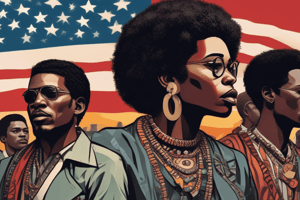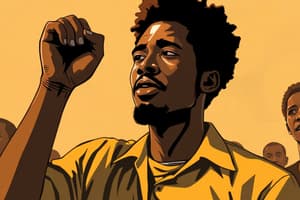Podcast
Questions and Answers
Where and when did the most famous sit-in take place?
Where and when did the most famous sit-in take place?
- 1960 in Greensboro, NC at a Woolworth's (correct)
- May 1961 in the Deep South
- Chicago in the 1940s
- Memphis, TN in April 1968
What was the result of the Freedom Rides?
What was the result of the Freedom Rides?
- News coverage forced the government to enforce desegregation laws (correct)
- The government denied involvement in the desegregation efforts
- The buses were desegregated, but the riders were arrested
- The Freedom Riders were attacked by white mobs
What was the purpose of the March from Selma?
What was the purpose of the March from Selma?
- To protest the treatment of African Americans in Birmingham
- To support Kennedy's civil rights bill
- To desegregate the entire state of Alabama (correct)
- To organize a nationwide boycott of Woolworth's
Why did Kennedy not act on Civil Rights at the start of his presidency?
Why did Kennedy not act on Civil Rights at the start of his presidency?
What was the main goal of the Civil Rights Act of 1964?
What was the main goal of the Civil Rights Act of 1964?
What is the term for the problem of women being restricted to traditional roles as wives and mothers?
What is the term for the problem of women being restricted to traditional roles as wives and mothers?
What was the primary goal of the Nation of Islam?
What was the primary goal of the Nation of Islam?
Who led the Student Nonviolent Coordinating Committee (SNCC)?
Who led the Student Nonviolent Coordinating Committee (SNCC)?
What was the outcome of the Watts Riots?
What was the outcome of the Watts Riots?
What was the main reason why some people turned away from the Civil Rights Movement?
What was the main reason why some people turned away from the Civil Rights Movement?
What was the significance of the 1950s in the Civil Rights Movement?
What was the significance of the 1950s in the Civil Rights Movement?
What is the primary goal of the NAACP?
What is the primary goal of the NAACP?
Flashcards are hidden until you start studying
Study Notes
The Black Power Movement
- Led by Stokely Carmichael
- Focused on achieving African American empowerment through a separate society
The Nation of Islam
- A black nationalist organization that advocated for a separate society for African Americans in the US
The Watts Riots
- 6-day riots in Los Angeles in response to the beating of a black cab driver
- Resulted in 34 deaths and thousands of injuries
The Black Panthers
- A militant black power group that used violence to achieve their goals
- Led by Bobby Seale and Huey Newton
The Decline of the Civil Rights Movement
- The violence of the black power movement led to a decline in public sympathy for the civil rights movement
The Early Years of the Civil Rights Movement
- 1940s: Truman desegregates the military and government
- 1950s: Brown vs. Board of Education, Little Rock Nine, and Montgomery Bus Boycott
Civil Rights Organizations
- NAACP (National Association for the Advancement of Colored People): aimed to end segregation in the US
- CORE (Congress of Racial Equality): an interracial group working for integration
- SCLC (Southern Christian Leadership Conference): created the concept of non-violent protest
- SNCC (Student Nonviolent Coordinating Committee): a youth group seeking immediate change for civil rights
- SNCC was unique due to its youth composition
Non-Violent Protest
- Peaceful protest of laws
SNCC Leadership
- Led by Robert Moses
Sit-Ins
- Entering a segregated area and refusing to leave
- First sit-in: Chicago in the 1940s
- Most famous sit-in: 1960 in Greensboro, NC at a Woolworth's
Freedom Rides
- Riding buses from the north into the Deep South to desegregate them
- Took place in May 1961
- Resulted in news coverage that forced the government to enforce desegregation laws
Confrontation at Ole Miss
- James Meredith attempted to attend the University of Mississippi, but was barred by the governor
- Kennedy sent US marshals to escort him to class
The March from Selma
- MLK's march to desegregate the entire state of Alabama
The Birmingham Campaign
- MLK's attempt to desegregate the city of Birmingham
- Led to massive attacks by Bull Connor and widespread news coverage, forcing the city and state to desegregate
"Letters From A Birmingham Jail"
- A series of editorials by MLK describing the civil rights movement while in a Birmingham jail
The March on Washington
- MLK organized a march on DC, where 200,000 people gathered to support Kennedy's civil rights bill
- MLK delivered his "I Have a Dream" speech at the march
Kennedy's Civil Rights Stance
- Initially, Kennedy did not act on civil rights due to his need for southern democratic support
- The violence in Birmingham changed his mind
The Civil Rights Act of 1964
- Banned discrimination in all aspects of life
The Voting Rights Act of 1965
- Allowed African Americans to register and vote in the south
- Resulted in 400,000 new African American voters in 1965
The 24th Amendment
- Removed poll taxes and literacy tests in voting
The Split in the Civil Rights Movement
- Split between non-violent and black power groups
- Black power groups felt the movement was too slow, and MLK was too accommodating to white people's demands
The Assassination of MLK
- MLK was killed in Memphis, TN on April 4, 1968 by James Earl Ray
Feminism
- The fight for equality between men and women
Wage Disparity
- In the 1960-70s, women earned 63 cents for every dollar earned by men
- Today, women earn 77 cents for every dollar earned by men
"The Problem That Has No Name"
- A concept coined by Betty Friedan to describe the limited roles assigned to women in society
NOW (National Organization for Women)
- Founded to achieve full equality for women
- Created by Betty Friedan
Studying That Suits You
Use AI to generate personalized quizzes and flashcards to suit your learning preferences.




